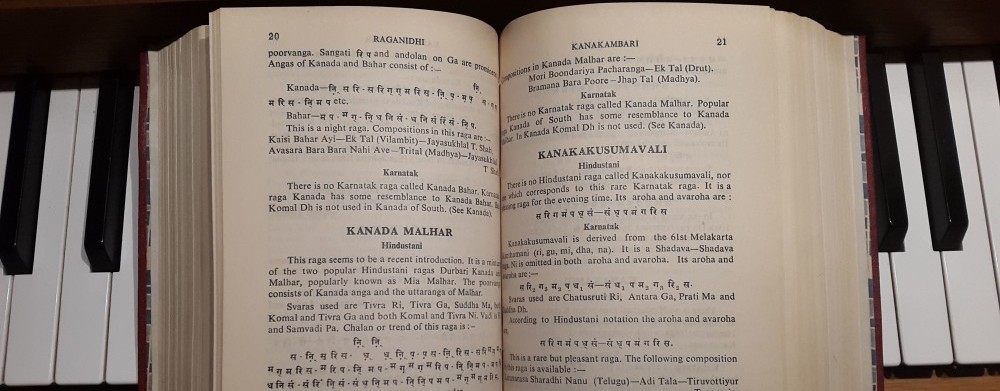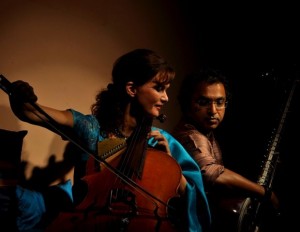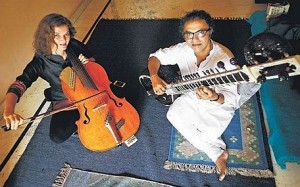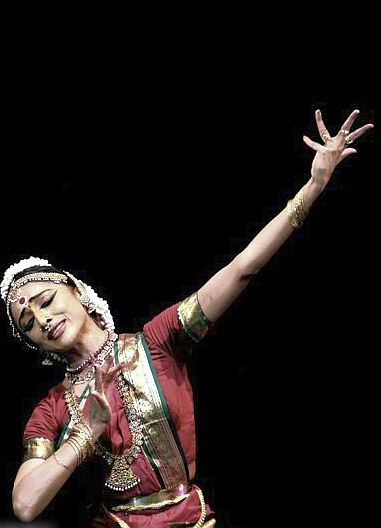A meeting up of world famous violin players from different classical traditions is not an evryday phenomenon. Recently it happened to Hindustani classical (raga) performer Kala Ramnath and Western classical player Hilary Hahn. Kala wrote a piece for Hilary and in this video she explains a few basics of raga music and about the piece she’s done for Hilary.
Category Archives: World Music
Wonderful concept for an enhanced experience of raga music: The Silence Concert
To help people experience the power of Indian classical music, married and musical couple cellist Saskia Rao de Haas and sitarist Shubhendra Rao started the Silence Concert movement, to experience music in its purest form: surrounded by silence. An intriguing, fascinating concept.
Saskia and Shubhendra explained their initiative in The Hindu of 19 September 2012 and here’s what they have to say about it on the Silence Concert Facebook-page they created:
“What is a Silence Concert?
For the sensitive listener, there can be a big difference in attending a concert and experiencing music. The effect that music can have on our lives, especially Indian music, is often lost by the social conventions that prevail at concerts: applause, talking before and after the concert, ceremonies, all of which take the attention away from the music itself. To help people experience the magical power of Indian music in a concert setting, Pt Shubhendra Rao and Saskia Rao initiated the Silence Concerts movement. In a Silence Concert the only sound that reverberates is music. There are no introductions, ceremonies, gimmicks, talks, speeches or applause. The setting is serene, beautiful and set up to experience beauty within through the pure experience of music. Through controlling external influences that can distract listener and performer the experience of pure music is enhanced.
Entering the auditorium for a Silence concert, the audience and artists leave behind their worries and daily masks, because they do not have to respond in word or gesture to the outside world. They can be gently led through a sublime journey within. What follows is that their experience turns within. The artist can share his music without playing to the gallery and the effect lingers after the concert, not interrupted by applause.
Abhinavagupta (approx. 950-1020 AD), the Indian philosopher, said that the ‘perfect audience is a spotless mirror of the performer’. Audience and performer become one in a Silence concert. The social context is taken out and the audience is left with a truly introspective experience, as is the performer.” (Saskia Rao de Haas and Shubhendra Rao)
Saskia and Shubhendra end with a quote of Sufi Inayat Khan (1882-1927):
“While tuning the tanpura, the artist tunes his own soul. Not only has he tuned the instrument, but he has felt the need of every soul in the audience and the demands of their souls, what they want at that time. He becomes an instrument of the whole cosmic system, open to all inspiration at one with the audience, in tune with the tanpura and it is not only music, but spiritual phenomena that he gives to the people…‘ The object of Indian music is the training of the mind and the soul, for music is the best way of concentration. If one only knows how to appreciate it and give one’s mind to it, keeping all other things away, one naturally develops the power of concentration. Besides the beauty of music, there is the tenderness, which brings life [and gratitude] to the heart. For the person of fine feelings life in this world is very trying. It is jarring and it sometimes has a freezing effect. It makes the heart, so to speak, frozen. If one can focus one’s heart on music, it is just like warming up something that was frozen. The joy of life depends upon the perfect tuning of mind and body.”
Big Fun: Secret Chiefs 3 nicely cover a sixties-recording of veena genius S. Balachander
For me watching this clip is big fun! The band Secret Chiefs 3 play a piece called ‘Vajra’.
‘Vajra’ by the Secret Chiefs 3 turns out to be a well done, enjoyable cover of veena genius S. Balachander’s sixties-recording of ‘Neethumahima’, a composition in raag ‘Hamsanandhi’, as you can check out in a YouTube-video (below) I published in 2008.
HOME
Gamelan music in my May 2012-edition of Concertzender’s ‘Wereldmineralen’
On Saturday May 12th 2012 Concertzender’s broadcast ‘World Minerals’/’Wereldmineralen’, produced by me, was dedicated to recent releases featuring gamelan music. The programme features three albums: [1] ‘Bali – Terompong Beruk’ (2011), played by musicians from the Balinese village Bangle, [2] ‘Java’ by the Sundanese group Sambasunda (2011) and [3] ‘Gamelan of Java – Volume Four: Puspa Warna’ (2010), played by musicians of The Institute of the Arts in Surakarta, Java. On this page you can play the programme ‘on demand’ (by clicking on the speaker icon) and you’ll find more information (in dutch) with a detailed playlist of the programme.
The album ‘Bali – Terompong Beruk’ also includes an interesting documentary, some of which can be seen in the video below.
Mesmerising overtone singing by Okna Tsahan Zam
Just found the video above of (my favourite) overtone singer Okna Tsahan Zam. He’s from Kalmykia and here he sings a segment of the heroic epic Dzhangar. Years ago I highlighted him in a radiospecial on overtone singing.
And below a video I already knew, with him also singing the Dzhangar epic:
Impressive overtones of Natascha Nikeprelevic
An artist I’ve been admiring for many years is Natascha Nikeprelevic. With overtone singing as her basic means of musical expression she performs, improvises and interprets contemporary music. For a reference: on her MySpace page she mentions Pina Bausch, Kazuo Ohno, Robert Wilson, Michael Vetter and Karlheinz Stockhausen as her most important influences. Here’s a beautiful excerpt from ‘Alice in Wonderland’, her ‘journey of the human natural voice to the wonderland of synthetic sounds’.
Is there anything Natascha Nikeprelevic can’t do with her voice?
In Natascha Nikeprelevic’s work harmonic melodies and overtone arias emerge from what seem to be amorphous sound structures, noises and almost bizarre atonalities. Since 1997 she collaborates with Michael Vetter. Natascha Nikeprelevic has performed all over Europe and in the Far East and besides performing she also lectures for programmes of musicology, dance/theatre and jazz at several universities in and outside Europe.
An overtone singing workshop led by Natascha Nikeprelevic
If you want to hear from herself about her music and career check out this interview with Deutschland Radio Berlin.
RECITAL’REZITATIV for voice and tambura
And speaking of Natascha’s work, I can’t resist referring to a video and a soundscape I made for fun a few years ago, in which her voice is one of the predominant elements. This one…
Bharata Natyam dancer Meenakshi Srinivasan on tour in The Netherlands and Belgium
Beginning of February 2012 multi-talented dancer Meenakshi Srinivasan tours in Holland and Belgium. She’s one of the most prominent performers of the classical temple dance bharata natyam, a dance style originating from South India with its earliest roots dating back to 1000 B.C. The repertoire of this traditional dance style is based on old choreographies depicting the classical myths and legends of Hindu deities.
Meenakshi doesn’t confine herself to tradition only. Based on modern themes and ideas she also creates new choreographies by combining the language of the bharata natyam with modern dance techniques. Meenakshi’s dancing is highly stylised and energetic, but looks playful and effortless at the same time.
Her performances in The Netherlands and Belgium are accompanied by voice, violin, nattuvangam (little cymbals) and mridangam (a two-sided drum). Meenakshi Srinivasan is a must for people interested in traditional and modern dance and in Indian classical music.
Tour Schedule (date – location / time):
Friday 3 February 2012 – Antwerp, Zuiderpershuis / 20:30
Saturday 4 February 2012 – Utrecht, RASA / 20:30
Sunday 5 February 2012 – Amsterdam, Tropentheater / 15:00
Thursday 9 February 2012 – The Hague, De Regentes / 20:15
The enchanting guitar playing of ‘Django’ virtuoso Sébastien Giniaux
Sébastien Giniaux is a marvellous french virtuoso guitarist. Absolutely brilliant. He plays all ‘the right notes’, does all the right timing, improvises with great imagination, knows exactly how to give the right feel to a piece and he incorporates in his compositions an interesting range of influences, varying from Balkan to Mali and from Classical to Gypsy Jazz/Jazz Manouche. This introduction to his latest album – ‘Mélodie des Choses’ – features some of his inspired playing with fellow musicians.
Membership Raga Unlimited more than doubled in 2011
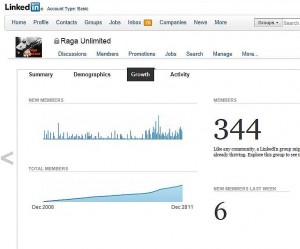 Raga Unlimited growth rate figures (click on picture to enlarge)
Raga Unlimited growth rate figures (click on picture to enlarge)
The LinkedIn-group that I run, Raga Unlimited, launched on 12 December 2008, has now 344 members. Anyone interested and registered on LinkedIn can join, that is, after (my) admission (don’t worry, there have been no refusals so far). A lot of knowledgeable people show up in the ranks. 37% works in the music industry and 16% is active in arts & design. In 2011 the group’s membership figure more than doubled, from 150 to 343, that’s an increase of 193 members in one year. Most people joined in May (28x), June (29x) and December (29x). Today, New Year’s Day 2012, I’ve already welcomed one more newbie, so we’re talking about a membership growth rate of 1 per day so far this year :).
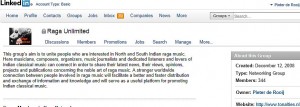
The group’s ‘mission statement’ (click on picture to enlarge)
Feel free to join if you’re interested.
Raga Unveiled – ambitious cinematic effort to grasp the essence of Hindustani classical music
I reported earlier on ‘Raga Unveiled’, an ambitious cinematic effort to take a look at the history and essence of the Hindustani classical music system. In this film – directed by Gita Desai and released in 2009 – scholars and great artists of today unveil the raga and demonstrate evrything you always would have liked to know about Indian classical music.
Here’s the trailer:
For anyone interested in raga music this 260 minute-film is a ‘must’ and of course it’s needless to say that you should see and buy the film on dvd in much better quality.
